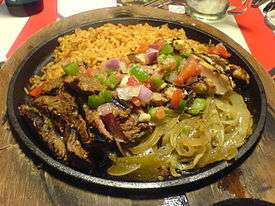Texan cuisine
| Part of a series on |
| American cuisine |
|---|
|
Regional cuisines
|
|
Ingredients and foods |
|
Ethnic and cultural |
|
Holidays and festivals |
|
| Wikibooks Cookbook has a recipe/module on |
Texan cuisine is the food associated with the U.S. state of Texas. Texas is a large state, and its cuisine has been influenced by a wide range of cultures, including Southern, German, British, African American, Cajun/Creole, Mexican, Native American, Asian, and to a lesser degree, Jewish and Italian.
Tex-Mex
| Wikibooks Cookbook has a recipe/module on |
| Wikibooks Cookbook has a recipe/module on |
Tex-Mex refers to a style of cooking that combines traditional Norteño (northern) Mexican cuisine adapted to the tastes and kitchen techniques of Texans of Anglo- and European origins. Tex-Mex cooking differs from traditional Mexican cooking by using different proportions or types of ingredients, such as meats (like ground beef), melted cheeses, and spices more suited to palates less disposed to piquant flavorings. Tex-Mex cuisine has influenced what is often called "Mexican" cuisine in many parts of the U.S. and Europe. Dishes associated with Tex-Mex cooking include guacamole, chile con queso, tostadas with red salsa, tortilla soup, nachos, tacos, enchiladas, fajitas, quesadillas, chimichangas, burritos, tamales, and carne guisada. Breakfast items include scrambled egg in flour tortilla tacos as migas and huevos con chorizo, huevos rancheros, and empanadas of various meats. Entrees are commonly accompanied by pan fried potato and refried beans. Deserts include flan, tres leches cake, fruit sherbets, and pralines.
Texas and barbecue

Barbecue is a Texas cuisine having characteristics which uniquely distinguish it.
Unlike other forms of cooking using pork or other meats, barbecue is beef. Beef brisket (slowly cooked in smoke in a wood fired "pit") is the most common barbecue. Other meats, particularly smoked sausage and pork or beef ribs often accompany barbecue. Techniques and flavors associated with barbecue in Texas show influences of European immigrants, especially Czech and German, as well as Mexican cuisines. Barbecue has inspired many styles of cooking other meats in wood smoke throughout the US and the world often calling themselves barbecue.
Barbecue in Texas is most commonly served with white bread, spicy sauces, pickles, sliced onion, and jalapeños; sides include pinto beans, potato or rice salad, and cabbage slaw. Common desserts served with barbecue are fruit cobbler, banana pudding, and pecan pie.
Hamburger
The earliest claim to the invention of the hamburger was Fletcher Davis of Athens, Texas, who was claimed to have served it at his restaurant at a time when there were more cows than people in Texas. According to oral histories, in the 1880s, he opened a lunch counter in Athens and served a "burger" of fried ground beef patties with mustard and Bermuda onion between two slices of bread; with a pickle on the side.[1] The claim is that in 1904, Davis and his wife Ciddy ran a sandwich stand at the St. Louis World's Fair. Historian Frank X. Tolbert noted that Athens resident Clint Murchison said his grandfather dated the hamburger to the 1880s with "Old Dave" a.k.a. Fletcher Davis. A photo of "Old Dave's Hamburger Stand" from the 1904 connection was sent to Tolbert as evidence of the claim.[2] Also the New York Tribune namelessly attributed the innovation of the hamburger to the stand on the pike.
Fajitas

The first culinary evidence of fajitas, as a cut of meat, the cooking style (directly on a campfire or on a grill), and the Spanish nickname going back as far as the 1930s in the ranch lands of South and West Texas,. During cattle roundups, beef cattle were butchered regularly to feed the hands. Throwaway items such as the hide, the head, the entrails, and meat trimmings such as skirt were given to the Mexican cowboys called vaqueros as part of their pay. Hearty border dishes like barbacoa de cabeza (head barbecue), menudo (tripe stew), and fajitas or arracheras (grilled skirt steak) have their roots in this practice. Considering the limited number of skirts per carcass and that the meat wasn't available commercially, the fajita tradition remained regional and relatively obscure for many years, probably only familiar to vaqueros, butchers, and their families.[3] The modern "fajitas" were introduced at a county fair in Kyle, Texas in 1969 by Sonny Falcon, who later opened an Austin restaurant offering fajitas as a main fare. Fajitas are generally marinated before grilling in a combination of lime juice and southwestern spices, and then served on a hot plate splashed with lime juice and eaten in taco style with flour tortillas, grated cheese, pico de gallo, sour cream, and guacamole.
Southern
Texas has a tradition of southern-style cuisine dating back to the 1830's from settlers and immigrants from the plantation states of the American deep south such as pan-fried chicken, field peas (such as black-eyed peas), greens (such as collard greens, mustard greens, turnip greens, or poke salad), mashed potatoes, cornbread or corn pone, sweet tea, and dessert — pies and cobblers. In Texas, many of these dishes often show the influence of having evolved concurrently with the influence of Ibero- and Mexican- cuisines.
Other foods
Texas is known for its own variation of chile con carne. Texas chili is made typically with hamburger-ground beef served alone or with kidney beans or rice, and in Frito pie, a dish made with the eponymous Fritos corn chip, invented in Texas and produced by Plano, Texas-based Frito-Lay corporation. Chicken fried steak is a traditional Texas dish, a variation on schnitzel that came to Texas along with German immigrants. Czech immigrants brought a tradition of kolache-making, a fruit-filled pastry or klobasniky, a sausage-filled pastry. German and Czech influences brought about a distinct Texas sausage making style marked by bold and sometimes piquant spicing and coarser texture. Southeast Texas cuisine shows strong Cajun and Creole influences in its foods. West Texas cooking is characterized by cowboy chuckwagon cooking. Crypto-Jews among the very earliest of Spanish colonial settlers in Texas brought Sephardic influences to cooking in Texas which remain today in Tex-Mex dishes absent lard or other pork product and in egg breads dominant in Tex-Mex pandulces. Apocryphally , there is Tex-Jex, a reference to much later influence of 20th century East- and Central European Jewish immigration.[4]
References
- ↑ Nancy Ross Ryan (February 6, 1989). "Restaurants & Institutions. Reed Business Information, Inc. (US)".
- ↑ John E. Harmon. "Atlas of Popular Culture in the Northeastern United States".
- ↑ Wood, Virginia B. (March 4, 2005). "Fajita History - Food - The Austin Chronicle". The Austin Chronicle. Retrieved February 25, 2013.
- ↑ Schmidt, Alex (January 6, 2012). "Jewish And Mexican Cooking Meet In 'Challa-peño' : NPR". NPR.
External links
- Tex-Mex foods at Texas State Historical Association
- Texas barbecue at Food Network
- Cuisine of Texas at Allrecipes.com
